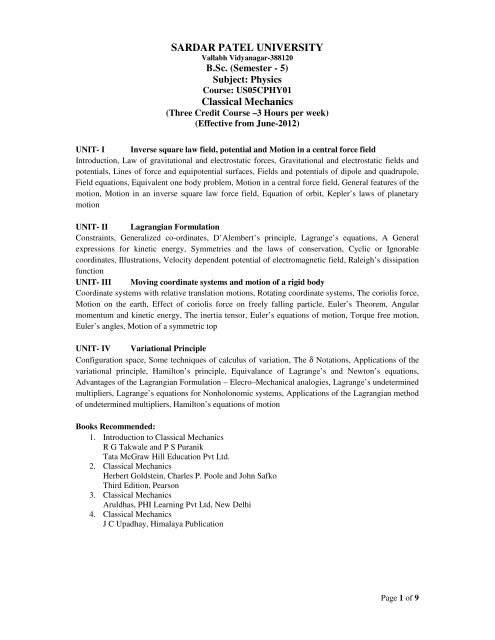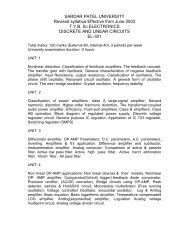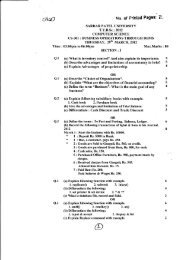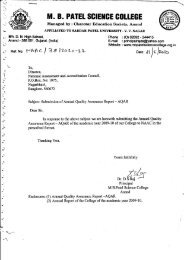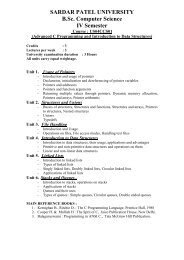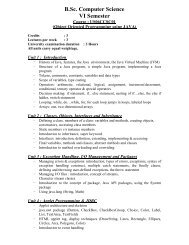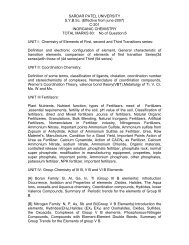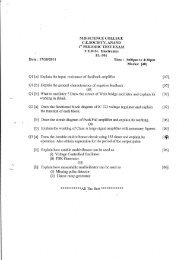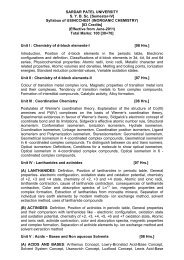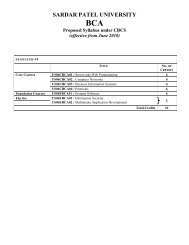SARDAR PATEL UNIVERSITY Classical Mechanics - MB Patel ...
SARDAR PATEL UNIVERSITY Classical Mechanics - MB Patel ...
SARDAR PATEL UNIVERSITY Classical Mechanics - MB Patel ...
- No tags were found...
You also want an ePaper? Increase the reach of your titles
YUMPU automatically turns print PDFs into web optimized ePapers that Google loves.
<strong>SARDAR</strong> <strong>PATEL</strong> <strong>UNIVERSITY</strong>Vallabh Vidyanagar-388120B.Sc. (Semester - 5)Subject: PhysicsCourse: US05CPHY01<strong>Classical</strong> <strong>Mechanics</strong>(Three Credit Course –3 Hours per week)(Effective from June-2012)UNIT- I Inverse square law field, potential and Motion in a central force fieldIntroduction, Law of gravitational and electrostatic forces, Gravitational and electrostatic fields andpotentials, Lines of force and equipotential surfaces, Fields and potentials of dipole and quadrupole,Field equations, Equivalent one body problem, Motion in a central force field, General features of themotion, Motion in an inverse square law force field, Equation of orbit, Kepler’s laws of planetarymotionUNIT- II Lagrangian FormulationConstraints, Generalized co-ordinates, D’Alembert’s principle, Lagrange’s equations, A Generalexpressions for kinetic energy, Symmetries and the laws of conservation, Cyclic or Ignorablecoordinates, Illustrations, Velocity dependent potential of electromagnetic field, Raleigh’s dissipationfunctionUNIT- III Moving coordinate systems and motion of a rigid bodyCoordinate systems with relative translation motions, Rotating coordinate systems, The coriolis force,Motion on the earth, Effect of coriolis force on freely falling particle, Euler’s Theorem, Angularmomentum and kinetic energy, The inertia tensor, Euler’s equations of motion, Torque free motion,Euler’s angles, Motion of a symmetric topUNIT- IV Variational PrincipleConfiguration space, Some techniques of calculus of variation, The δ Notations, Applications of thevariational principle, Hamilton’s principle, Equivalance of Lagrange’s and Newton’s equations,Advantages of the Lagrangian Formulation – Elecro–Mechanical analogies, Lagrange’s undeterminedmultipliers, Lagrange’s equations for Nonholonomic systems, Applications of the Lagrangian methodof undetermined multipliers, Hamilton’s equations of motionBooks Recommended:1. Introduction to <strong>Classical</strong> <strong>Mechanics</strong>R G Takwale and P S PuranikTata McGraw Hill Education Pvt Ltd.2. <strong>Classical</strong> <strong>Mechanics</strong>Herbert Goldstein, Charles P. Poole and John SafkoThird Edition, Pearson3. <strong>Classical</strong> <strong>Mechanics</strong>Aruldhas, PHI Learning Pvt Ltd, New Delhi4. <strong>Classical</strong> <strong>Mechanics</strong>J C Upadhay, Himalaya PublicationPage 1 of 9
<strong>SARDAR</strong> <strong>PATEL</strong> <strong>UNIVERSITY</strong>Vallabh Vidyanagar-388120B.Sc. (Semester - 5)Subject: PhysicsCourse: US05CPHY03Solid State Physics(Three Credit Course –3 Hours per week)(Effective from June-2012)UNIT - I X-ray diffractionIntroduction of X-ray, Neutron and electron diffraction, X-ray diffraction and Bragg’s law,Experimental diffraction methods, Laue’s Method, Rotating crystal Method and Powder Method fordetermination of crystal structure, Reciprocal lattice and Bragg’s law, Concept of reciprocal lattice,Geometrical construction of reciprocal space, Vector algebraic discussion of reciprocal and real spacevectors, Properties of reciprocal lattice, Analysis of X-ray diffraction pattern from crystal, Structurefactor for bcc crystal, Structure factor of mono atomic diamond lattice, Structure factor of polyatomiccrystal, Measurement of diffraction pattern of crystal, The Ewald constructionUNIT - II Free electron Fermi GasIntroduction of the free electron gas, Drude model, DC electrical conductivity of metals, Thermalconductivity of metals, Lorentz modification to Drude model, Energy levels and Density of orbital inone dimension, Effect of temperature on Fermi-Dirac distribution function, Free electron gas in threedimension, Heat capacity of the electron gas, Electrical Conductivity and Ohm’s Law, ExperimentalElectrical resistivity of metals, Thermionic Emission, Motion in magnetic field (Hall effect), Hallvoltage and Hall coefficient, Mobility and Hall angle, Importance of Hall effect Superconductivity:Flux exclusion – The Meissner Effect, Thermal Properties, The Energy Gap, Isotope Effect,Mechanical Effect, The Penetration Depth, Type-I and Type-II SuperconductorsUNIT- III Semiconducting and Optical Properties of MetalsIntroduction, Semiconductors, Free carrier concentration in semiconductors, Fermi Level and carrierconcentration in semiconductors, Mobility of Charge carriers, Effect of temperature on mobility,Electrical conductivity of semiconductors, Hall effect in semiconductors, Junction properties,Absorption processes, Photoconductivity, Brief review of photoelectric effect, Photovoltaic effect,Photoluminesence, Colour centers, Types of Colour centers, Generation of colour centersUNIT – IV NanoscienceIntroduction to Nanoscience, Some Nano Challenges, The fundamental Science BehindNanotechnology, Tools for Measuring Nanostructures, Tools to Make Nanostructures, Point andPlaces of Interest (Sensors, Nanoscale Biostructures, Energy capture, Transformation and storage,Optics, Magnets, Fabrication, Electronics), Smart Materials (Self-Healing Structures, Recognition,Separation, Catalysts)Recommended Books:1. Introduction to Solid State PhysicsC. Kittel, (5 th Edition)Wiley Eastern Ltd.2. Elements of Solid State PhysicsJ. P. Srivastava, Prentice-Hall of India3. Solid State PhysicsM. A. Wahab, Narosa Publishing House4. Solid State PhysicsS.O.Pillai,New Age International Publisher5. Elementary Solid State PhysicsM. Ali. Omar, Pearson Education.6. Nanotechnology A Gentle Introduction to the Next Big IdeaMark Ratner and Daniel Ratner, Pearson EducationPage 3 of 9
<strong>SARDAR</strong> <strong>PATEL</strong> <strong>UNIVERSITY</strong>Vallabh Vidyanagar-388120B.Sc. (Semester - 5)Subject: PhysicsCourse: US05CPHY04Thermodynamics and Statistical Physics(Three Credit Course –3 Hours per week)(Effective from June-2012)UNIT-I ThermodynamicsLaws of Thermodynamics, Maxwell’s Thermodynamical Relations, Helmholtz Function,Thermodynamical Potential, Gibbs Function, Enthalpy, Maxwell’s Equations (Alternative method)First-order phase transitions, Second-order phase transitions, The T dS Equations, Related NumericalsUNIT-II Fundamentals of Statistical <strong>Mechanics</strong>Macroscopic and microscopic states, Phase space, Liouville’s theorem, Fluctuations in a physicalquantity, Microcanonical Ensemble: Microcanonical distribution, Microcanonical average, Equal apriori probability, Additive property of entropy, Entropy of a perfect gas in a Microcanonicalensemble, Gibbs paradox, Removal of Gibbs paradox, Thermodynamic quantities in a Microcanonicalensemble, Average energy per particle, Specific heat at constants volume, Sackur-Tetrode formula,Nernst’s heat theorem, Related NumericalsUNIT-III Statistical <strong>Mechanics</strong>Canonical Ensemble: Canonical distribution, Canonical average, Canonical partition function,Maxwell-Boltzmann distribution of velocities, Maxwell-Boltzmann distribution of absolute velocity,Most probable velocity, Mean kinetic energy, Thermodynamic quantities in a canonical ensemble,Equivalence of Microcanonical and canonical ensembles, Grand Canonical Ensemble: GrandCanonical distribution, Grand Canonical average, Grand Canonical partition function,Thermodynamic quantities in a Grand canonical ensemble, Related NumericalsUNIT-IV Three DistributionsMaxwell-Boltzmann Distribution, Fermi-Dirac distribution, Bose-Einstein Distribution, Entropy ofthe gas, Evaluation of β, Evaluation of α, Condition for applicability of <strong>MB</strong> distribution Applicationsof Maxwell-Boltzmann Distribution: Energy distribution function, Energy distribution law, Partitionfunction, Most probable energy, Total number of particles, Average energy, Velocity distributionfunction, Total number of particles, Most probable velocity, Average velocity and Root mean squarevelocity, Related NumericalsBooks Recommended:1. Heat and ThermodynamicsBrijlal and SubrahmanyamS Chand Publication2. A textbook of Statistical <strong>Mechanics</strong>Suresh ChandraCBS Publishers3. Statistical <strong>Mechanics</strong>,B K Agarwal and Melvin EisnerNew Age International Limited Publishers4. Fundamental of Statistical <strong>Mechanics</strong>B B Laud, New Age International PublicationPage 4 of 9
<strong>SARDAR</strong> <strong>PATEL</strong> <strong>UNIVERSITY</strong>Vallabh Vidyanagar-388120B.Sc. (Semester - 5)Subject: PhysicsCourse: US05CPHY05Analog Devices and Circuits(Three Credit Course –3 Hours per week)(Effective from June-2012)UNIT-I FET and MOSFETIntroduction, Basic Ideas, Drain curves, Transconductance curves, Biasing in the ohmic region,Biasing in the active region, Transconductance, JFET amplifiers, The JFET analog switch, OtherJFET applications, The depletion mode MOSFET, The enhancement mode MOSFET, CMOSUNIT-II Frequency Response of Amplifiers and Tuned AmplifiersFrequency Response of Amplifiers: Introduction to Hybrid h- Parameters, Obtaining Hybrid h-Parameter, Amplifier Equations, Low Frequency Response of The Transistor Amplifier, Effect ofEmitter Bypass, Capacitor on Low Frequency response, Effect of Coupling Capacitor on LowFrequency response, High Frequency Response of The Transistor Amplifier, High FrequencyModel For The Common Emitter Amplifier, Approximate CE High Frequency Model with aResistive Load, CE Short Circuit Gain, High Frequency Current Gain with a Resistive Load, TunedAmplifiers: Introduction to Tuned Amplifiers, Classifications of Small Signal Tuned Amplifiers,Single Tuned Inductively Coupled AmplifierUNIT-III Transistor Power AmplifiersClass A Direct Coupled Resistive Load, Transformer Coupled Resistive Load, Design Theory,Power Amplifier Design, Harmonic Distortion, Power Output, Variation of output power with load,Output transformer saturation, Disadvantages of a single ended transformer coupled amplifier, Push-Pull Amplifiers: Description of Operation of a Class A Push-Pull Amplifier, Theory of Operation ofa Class A Push-Pull Amplifier, The Class B Push-Pull Amplifier, Crossover Distortion, Class ABPush-Pull Amplifier, Transistor Phase Inverter, Conversion Efficiency of a Class B Amplifier,Relation between maximum output power and load resistance, Other Class B Push-Pull Amplifiers,Complementary SymmetryUNIT-IV Operational AmplifiersOperational Amplifier Characteristics: Basic Differential amplifier analysis, DC Analysis of theBipolar Diff. Amplifier, AC Analysis of the Bipolar Diff. Amplifier, The Common mode rejectionratio –CMRR, The Ideal Operational Amplifier -Op-Amp., Inverting and Noninverting Amplifiers –Ideal case, Op-Amp Parameters –Definitions, Universal Balancing Techniques, Measurements of Op-Amp Parameters, General Description of various Stages in Op-Amp, Applications of operationalamplifier: Summing amplifier (Inverting Mode) and Difference amplifier, The Integrator andDifferentiator, Current to Voltage Converter, Voltage to Current Converter- Floating Load,Logarithmic Amplifier using diode(Basic only) Active filters: Introduction, General characteristics offilters, Various filter responses, First-order active filters (Basic Low-Pass and High-Pass filters)Books Recommended:1. Electronic Principles, P Malvino, Tata McGraw Hill Pub. Co.Ltd, New Delhi2. Electronic Devices and Circuits, Allen Mottershead, PHI Pvt.Ltd., New Delhi3. Electronic Devices and Circuits, G K Mittal, Khanna Publishers, New Delhi4. Integrated Circuits, K R Botkar, Khanna Publishers, New Delhi5. Integrated electronics: analog and digital circuits and systemsJacob Millman and Christos C. Halkias, Tata McGraw Hill Pub.Co.Ltd, New DelhiPage 5 of 9
<strong>SARDAR</strong> <strong>PATEL</strong> <strong>UNIVERSITY</strong>Vallabh Vidyanagar-388120B.Sc. (Semester - 5)Subject: PhysicsCourse: US05CPHY06Astronomy and Astrophysics(Three Credit Course –3 Hours per week)(Effective from June-2012)UNIT-I Astronomical Instruments and Astronomical MeasurementsAstronomical Instruments: Light and its properties, The Earth’s atmosphere and EM radiation,Optical telescopes, Radio telescopes, Hubble Telescope, Astronomical spectrograph, Photographicphotometry, Photoelectric photometry, Spectrophotometry, Detectors and Image processingAstronomical measurements: Stellar magnitude sequence, Absolute magnitude and distancemodulus, The bolometric magnitude, Different magnitude standards (UBV and six color),Radiometric magnitude, The color index of a star, Stellar parallax and units of stellar distances, Stellarpositions, Stellar motions, The solar motion and the peculiar velocities of stars, Velocity dispersion,Statistical parallax, Moving cluster parallaxUNIT-II The SunSun – a typical star, Photosphere limb darkening, Solar Granulation, Faculae, The Chromosphere,Solar corona, Prominences, The 11 year solar cycle, Solar magnetic fields, Theory of sunspots, Solarflares, Radio emissions from Sun, Solar wind, Solar neutrino puzzleUNIT-III Spectral Classification of Stars, Binary and Multiple StarsSpectral Classification of Stars: Introduction, Boltzmann’s formula, Saha’s equation of thermalionization, Harvard classification – HD catalogue, Luminosity effect on stellar spectra, Importance ifionization theory in Astrophysics, Spectroscopic parallax, The H-R diagramBinary and multiple stars: Introduction, Visual binaries, Spectroscopic binaries, Eclipsing binaries,Multiple stars, Origin of binary stars, Stelar masses and mass luminosity relation, Mass transfer inclose binary systemUNIT-IV Our GalaxyIntroduction, Rotation of the galaxy, Determination of rotational parameters in solar neighborhood,Radio observation of galaxy at 21 cm wave length, Rotation curve of the galaxy, Density distributionof gas and spiral structure, Radio and optical data, The general structure of our galaxy, The mass ofour galaxy, Magnetic field in our galaxy, Cosmic rays, Continuous radio emission in our galaxyBooks Recommended:1. An Introduction to AstrophysicsBaidyanath Basu, Tanuka Chattopadhyay and Sudhindranath BiswasPrentice Hall India2. Astronomy and AstrophysicsA.B.Bhattacharya, Overseas Publication3. Astrophysics of the Solar systemOrient, Orient LongmanPage 6 of 9
<strong>SARDAR</strong> <strong>PATEL</strong> <strong>UNIVERSITY</strong>Vallabh Vidyanagar-388120B.Sc. (Semester - 5)Subject: Physics PracticalsCourse: US05CPHY07General Physics, Electricity, Magnetism and Transducers(Three Credit Course –3 Hours per week)(Effective from June-2012)List of Practicals:1. Hall effect( constant magnetic field)2. Capacitance by de Sauty’s method3. Phage angle by C. R. O.4. Constants of ballistic galvanometer5. Low resistance by ballistic galvanometer6. Four probe method7. Hysteresis curve8. Young’s modulus by Searl’s method9. Resonance pendulum10. Strain gauge characteristicsNote: To provide flexibility up to the maximum of 20% of total experiments can be replaced/ addedto the list by the board of studies.Books Recommended:1. Advanced Practical Physics for studentsB L Wosnop and H T Flint, Methuen and Co. Ltd., London2. B.Sc. Practical PhysicsC L Arora, S.Chand & Co. Ltd., New Delhi3. Advanced Practical PhysicsM S Chauhan and S P Singh, Pragati Prakashan, Meerut4. Advanced Practical PhysicsS L Gupta and V Kumar, Pragati Prakashan, Meerut5. An advanced course in practical PhysicsD Chattopadhyay and P C Rakshit, New Central book agency Pvt. Ltd.Page 7 of 9
<strong>SARDAR</strong> <strong>PATEL</strong> <strong>UNIVERSITY</strong>Vallabh Vidyanagar-388120B.Sc. (Semester - 5)Subject: Physics PracticalsCourse: US05CPHY08Electronics and Communication(Three Credit Course –3 Hours per week)(Effective from June-2012)List of Practicals:1. Astable and Monostable Multivibrator2. MOSFET characteristics3. Class A amplifier4. Operational amplifier (Inverting and non inverting modes)5. Frequency response of OpAmp6. Logic gates (discrete and IC based AND, OR,NOT NAND and NOR gates)7. Flip-flops (RS, JK, D)8. Amplitude modulation and demodulation9. Optical fiber (To find numerical aperture for optical fiber)10. Computer simulation of Analog electronic circuitsNote: To provide flexibility up to the maximum of 20% of total experiments can be replaced/ addedto the list by the board of studies.Books Recommended:1. Advanced Practical Physics for studentsB L Wosnop and H T Flint, Methuen and Co. Ltd., London2. B.Sc. Practical PhysicsC L Arora, S.Chand & Co. Ltd., New Delhi3. Advanced Practical PhysicsM S Chauhan and S P Singh, Pragati Prakashan, Meerut4. Advanced Practical PhysicsS L Gupta and V Kumar, Pragati Prakashan, Meerut5. An advanced course in practical PhysicsD Chattopadhyay and P C Rakshit, New Central book agency Pvt. Ltd.Page 8 of 9
<strong>SARDAR</strong> <strong>PATEL</strong> <strong>UNIVERSITY</strong>Vallabh Vidyanagar-388120B.Sc. (Semester - 5)Subject: Physics PracticalsCourse: US05CPHY09Optics, Solid State Physics, Energy Science & Numerical Analysis(Three Credit Course –3 Hours per week)(Effective from June-2012)List of Practicals:1. Michelson interferometer2. Edser butler plate. To calibrate spectrometer3. Refractive index by total internal reflection using Gauss eye piece4. Thickness of a thin wire using optical bench5. Determination of lattice parameter by X-ray from a photograph (powder method)6. Dissociation of I 2 molecule7. Solar cell characteristics8. Searl’s Goniometer (Fixed distance)9. Diagonalization of a matrix (Jacobi method)10. Numerical differentiation (computer related)Note: To provide flexibility up to the maximum of 20% of total experiments can be replaced/ addedto the list by the board of studies.Books Recommended:1. Advanced Practical Physics for studentsB L Wosnop and H T Flint, Methuen and Co. Ltd., London2. B.Sc. Practical PhysicsC L Arora, S.Chand & Co. Ltd., New Delhi3. Advanced Practical PhysicsM S Chauhan and S P Singh, Pragati Prakashan, Meerut4. Advanced Practical PhysicsS L Gupta and V Kumar, Pragati Prakashan, Meerut5. An advanced course in practical PhysicsD Chattopadhyay and P C Rakshit, New Central book agency Pvt. Ltd.Page 9 of 9


